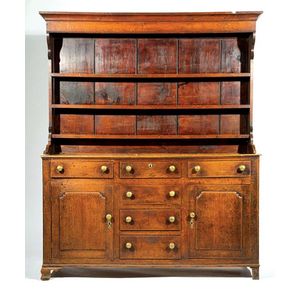Georgian Walnut Bureau Bookcase
You must be a subscriber, and be logged in to view price and dealer details.
Subscribe Now to view actual auction price for this item
When you subscribe, you have the option of setting the currency in which to display prices to $Au, $US, $NZ or Stg.
- Proportions - Essentially, the size of the various parts of a piece of furniture in relation to the whole. Ideally, the proportions should be pleasing to the eye appearing neither top-heavy nor unbalanced and convenient for ordinary use.
- Fall Front - Furniture with a hinged flap, usually associated with desks and secretaires, that opens or 'falls' to provide a flat writing surface. The flap may be supported by chains or brass quadrants and rest on wooden supports or runners, known as lopers, that pull out from a recess in either side of the piece. The interior of a fall-front desk is usually fitted with small drawers and pigeonholes.
- Bureau Bookcase - In a bureau bookcase, the upper section is a conventional bookcase with wooden or glazed doors, the centre section includes a bureau with the usual drawers and pigeon-holes and a fall-front writing surface, while below there are cupboards or drawers.
- Georgian - As an English stylistic period, Georgian is usually taken to cover the period from George I (1714) to the Regency of Prince George (1811-20), although the period from 1800 to 1830 is sometimes designated as the Regency period. During the Georgian period the great English cabinetmakers and designers such as Chippendale, Hepplewhite, Adam Sheraton etc., were all active.
Therefore there isn't a single 'Georgian style' as such and to say something is 'Georgian', usually means it was made between 1714 and 1830. This assumes we discount George V and George VI, both being from the 20th century.
The styles popular at the time of each reign were:
George I (1714-1727) saw out the last years of the Baroque period.
George II (1727-1760) reigned during the Rococo period.
George III (1760-1820) saw the last gasp of the Rococo, all of the early Neo-Classic 'Adam style' and most of the later neo-Classic 'Regency style'.
George IV (Prince Regent 1820-1830)encompassed the last of the 'Regency' style.
William IV's reign (1830-1837) was something of a no man's land (stylistically) and he wasn't a 'George' anyway. He covered the last glimmerings of 'Regency' and the start of the 'Victorian' style. - Bracket Feet - On bracket feet the corner edge is square and joined by a mitre to its partner on the opposite angle. The inner edge is usually shaped or scalloped. Bracket feet were first introduced in the early 18th century and used until c. 1830 and are found on carcase furniture such as chests, cabinets, bookcases and bureaux.
Ogee bracket feet, a variation on straight bracket feet, have the outside edge forming an "S" shaped curve with the top bulging outward and the bottom turning inward.
On splayed bracket feet, the exterior edge curves outward.
This item has been included into following indexes:
Visually similar items

A George III oak bureau bookcase, English circa 1780, 225 cm high, 105 cm wide, 56 cm deep

Early/mid Georgian oak Welsh dresser of traditional form with three shelf plate rack back, the base with three frieze drawers, three central drawers flanked by cupboards on block feet

An early 19th century glazed door bookcase, circa 1825 the shaped cross-banded cornice above two glazed doors with astragal bars enclosing adjustable shelves, the lower section with two panelled cupboard doors enclosing a single shelf, reeded brass door tr

An English mahogany 19th century four drawer drop front bureau bookcase. Height 216 cm, width 97 cm, depth 53 cm.
